Reinforcement of the screed: the choice of reinforcing elements and the features of their installation in the screed
The most durable coatings used to level the floors are screeds - concrete or cement-sand. Subject to the technology of kneading and pouring, they serve for many decades, without requiring repair. However, the couplers also have a significant drawback - they do not differ in tensile strength, therefore, when tensile loads are easily cracked. For example, during the drying process or when moving on an unstable, "floating" base. To prevent the formation of cracks, perform the reinforcement of the screed by introducing reinforcing elements into its thickness.
Content
When is screed reinforcement necessary?
Reinforced screed is, in fact, a special case of a reinforced concrete product that can withstand compressive, bending, tensile loads. The reinforcing elements embedded in the screed body perform such functions:
- protect against microcracks during drying of the screed;
- protect from the formation of cracks and their expansion when exposed to mechanical pressure or vibration;
- increase the strength of the screed;
- prevent subsidence of the base;
- increase the life of the screed.
Naturally, reinforcement is an optional process. And in most cases of individual construction, the screed perfectly copes with its functions without reinforcing elements.
Reinforcement is required if:
- The screed is laid on an unreliable, "floating" base, subject to bending and stretching. For example, when installing a multilayer floor, when the screed is poured onto a heat, sound or waterproofing layer. Such interlayers can be mineral wool slabs, EPSS, polystyrene foam, plastic films, etc. Loose mobile bases are also backfill from crushed stone, expanded clay, etc.
- It is required to strengthen the screed in places of increased load - under stoves, fireplaces, machine tools, mechanisms, etc.
- A thick screed is made - over 50 mm thick.
Typically, screeds in houses and apartments are a thin layer of cement-sand mortar with a thickness of 30-40 mm, which is used to level the floor on existing reinforced concrete slabs. In this case, a strong base does not allow tensile loads to occur, leading to deformations. So, reinforcement for such screeds is not performed.
Reinforcing elements: how do they strengthen the screed?
The following materials can be used to reinforce the screed:
- metal mesh (including road, originally intended to strengthen the roadway);
- polymer mesh - made of plastic;
- fiberglass mesh;
- fiber - microfibers made of polypropylene, glass, basalt, metal (steel).
The most durable and reliable reinforcement is performed using metal grids that distribute the loads in the construction of the screeds and protect them from damage during bending. Metal nets are able to maintain the shape of thick screeds, subject to significant loads - in workshops, in warehouses, in shopping centers, offices. In individual construction, reinforcing with metal mesh is a guarantee of trouble-free operation of the screed for many decades.
Polymer and fiberglass nets work weaker than metal ones, therefore they are used for screeds subject to light loads. As a rule, these are floors in apartments and private houses.
To strengthen the screeds, fiber is also used - bulk fibers from various materials that interfere with the composition of the solution. The use of fiber reduces the risk of shrinkage of microcracks, makes the screed monolithic and increases its impact strength. But to replace the "power" reinforcement with fiber nets is not able. In other words, the screed with fiber will be able to ideally dry without cracks and shrinkage, but it will not be able to resist large tensile and bending stresses.
We will deal with each type of reinforcing elements in more detail.
Option # 1 - metal mesh
Special metal mesh for reinforcement is made from steel wire BP-1, connected by spot welding. The diameter of the wire used is 2.5-6 mm.
The wire in the reinforcing mesh forms square or rectangular cells of different sizes - from 50 mm to 200 mm. The smaller the cells, the more metal used in the mesh, respectively, the higher the strength of the reinforcement. The most popular nets are made of wire with a diameter of 3 mm, with square cells with sides 100 mm, 150 mm, 200 mm.
Nets are supplied in rolls or cards (sheets). Rolls are easier to transport, however, “twisting” in this way can only be a mesh of thin wire with a thickness of not more than 2-3 mm The standard width of such rolls is 1-1.5 m, the length reaches 25 m. The main part of the reinforcing nets is produced in cards with dimensions of 0.5x2 m, 1x2 m, 2x3 m, 2x4 m, etc.
The main advantages of a metal mesh for reinforcement:
- high tensile strength, which during reinforcement is transferred to the screed;
- resistance to temperature changes, heating, freezing;
- binding ability, allowing to maintain the shape of the screed even at high loads;
- unlimited service life.
The main purpose of the metal mesh is to distribute the load in the thickness of the screed, increase its strength and thereby reduce the risk of subsidence, cracks, potholes and any other deformations. The wire rods of the mesh take on tensile stresses and protect the floor structure from damage during bending and stretching. Accordingly, the bearing capacity of the screed is increased.
When reinforcing, the mesh is laid inside the screed - in the lower third of its thickness. In this case, the mesh must be raised above the subfloor in order to “work” in the body of the screed, and not beyond. You can raise the mesh above the base by installing it on special plastic supports of the required height (pieces of drywall or other similar material are also used).
To lay the screed reinforced with a metal mesh, do the following:
- They clean the floor surface from debris, exfoliated pieces of concrete, dust.
- All detected cracks and cracks are filled with mortar or putty.
- Primed surface.
- If necessary, hydro, heat or sound insulating material is laid on a primed base.
- Determine the height of the screed. To do this, using a hydraulic level or a laser level, marks are made on the walls of the room (at the same height). When connecting all the received points, they get an absolutely flat line relative to the horizon. From this line measure the distance to the existing floor level - at several points. Where the distance is minimal, the highest point of the floor, you can “count” the desired thickness of the screed from it (here the thickness of the screed will be the thinnest). From the highest point up, measure the thickness of the screed (minimum thickness 2.5 mm), mark this level on the wall. A new horizontal line is drawn along the found point - the surface of the future screed will pass along it.
- Mount the grid, laying its overlap cloths on at least one cell.
- Guiding beacons (metal profiles, slats, boards) are installed on the grid, fixing them to a cement-sand mortar or with screws. The lighthouses are set strictly in level, so that their upper part is flush with the surface of the future screed (along the line previously marked on the wall). The distance between the beacons is about 1 m, but not more than the length of the rule used, which will stretch the screed.
- In between the beacons, pour the solution and level it, pulling the rule.
- After a few hours, when the supporting surface appears on the screed (traces no longer form), the beacons are taken out and the recesses are closed from them with a fresh solution.
- To avoid quick drying of the solution and the formation of cracks, the surface of the screed is moistened with water for 5-7 days. On hot days, it is additionally recommended to cover the screed with plastic wrap or other moisture-retaining material.
Thus, the reinforcement procedure does not greatly complicate the technology of screed creation. At the same time, it significantly improves its operational characteristics.
Option # 2 - Plastic Mesh
When reinforcing unloaded screeds up to 80 mm thick, the metal mesh can be replaced with a polymer counterpart - a mesh made of polypropylene (plastic).
Plastic mesh, unlike metal, is lighter and more flexible. This allows her to stretch without deforming and retaining all her qualities. This property can be very useful in shrinking a building. The resulting shrinkage deformation will simply stretch the mesh and the screed will retain its integrity. In the same situation (with significant shrinkage), the metal mesh can “lead” and it will break the screed.
Most often, reinforcement is used as a general construction plastic mesh - OSS. It is delivered in rolls with dimensions: width - 1-4 m, length - 10-50 m. The weight of such a net is very small, so it can be easily transported and then mounted in a screed of any configuration. The reduction of labor costs during reinforcement is also facilitated by the simple cutting of polypropylene cells into pieces.
Plastic mesh is not subject to corrosion, it is not affected by aggressive environments. The appearance of rust in the mass of cement mortar and, as a consequence, the appearance of red spots on the surface of the screed are excluded.
Advantages of polymer mesh as a material for screed reinforcement:
- increased elasticity;
- exceptional tensile strength;
- chemical inertness (does not rust, does not interact with chemical media);
- the ability to not shield communications (plastic does not interfere with radios, televisions, telephones, walkie-talkies.);
- high geometric stability;
- light weight;
- easy installation, so you can save on labor;
- low cost.
Screed reinforcement using plastic mesh is performed in the same way as with a metal mesh.
Option # 3 - fiberglass mesh
Another option for reinforcing screeds is the use of fiberglass nets. These are grids with square cells (usually 4-6 mm) made of aluminoborosilicate glass by openwork weaving.
There are several brands of fiberglass nets, some of which are impregnated with polymer alkali-resistant dispersions to improve performance. You need to pay attention to this when buying. The brands SSP-95 and SSDor-330 (road mesh) are coated with impregnation, but their closest "relatives" SSM-85 and SSDor-300 are not. Alkali-resistant impregnations play an important role. The fact is that the cement mortar of the screed in which the mesh will be located has an alkaline reaction. Exposed fiberglass in an aggressive alkaline environment can be "eaten" (usually this occurs within 5 years). To prevent this, the nets are coated with a polymer composition that is neutral to alkali.
Fiberglass is very light, does not create unnecessary loads on the ceiling. Due to its light weight and the possibility of twisting into rolls, the material is easy to transport even on non-freight vehicles or transport manually.
In the screed, fiberglass performs the same functions as the plastic mesh. That is, it prevents the occurrence of shrinkage cracks and local fractures, increases the strength of the screed.
Advantages of fiberglass mesh:
- light weight;
- high tensile strength;
- resistance to temperature differences;
- resistance to the aquatic environment;
- chemical neutrality (in the case of alkali-resistant impregnation);
- simple installation.
Installation of fiberglass nets is the same as with other types of nets.
Option # 4 - fiber reinforcement screeds
Fiber reinforcement is another option that differs significantly from the usual laying of a local mesh in a screed. Fiber is a mound of small reinforcing fibers (on average, 6-20 mm long, but metal fiber can be much longer - up to 50-60 mm), which interfere with the screed solution and then form a whole with it. In this case, it is customary to talk about volumetric multidirectional reinforcement, in which fiber fibers are evenly distributed over the entire thickness of the screed.
Fiber for screed can be made of metal (steel), polypropylene, basalt fiber or fiberglass. Each species differs in its application features. For example, if it is important not to load the screed when reinforcing, use polypropylene or glass fiber. For floors with high traffic, metal fiber is more suitable. For screeds exposed to difficult atmospheric conditions or aggressive substances - basalt fiber.
Fiber in the screed allows you to avoid the appearance of microcracks when the solution dries and the building shrinks. If a crack nevertheless appeared (for example, from the influence of a power load or vibrations), then, unfortunately, it will not be able to keep it from expanding fiber. That is, fiber is not able to serve as a complete replacement for reinforcing nets.
In order to perform reinforcement of the screed with fiber, it is necessary to mix bulk fibers into the solution. Mixing is performed in a concrete mixer. First, dry solution components and fiber are loaded into a pear, the mass is mixed for 3-5 minutes. During this time, the crumpled fiber will delaminate into fibers and be evenly distributed in the composition. Then add water and continue stirring for another 5-10 minutes. The finished solution is used to make screeds on lighthouses.
Fiber Advantages:
- facilitates reinforcement technology;
- protects against shrinkage cracks;
- strengthens the screed throughout the volume;
- increases the resistance of the screed to abrasion;
- increases the water resistance of the screed;
- increases frost resistance and resistance to sharp temperature jumps.
A feature of the fiber is that it can be combined with any reinforcing mesh. Thus, it is possible to achieve the greatest hardening of the screed and minimize the risk of both shrinkage cracks and defects that occur during operation.

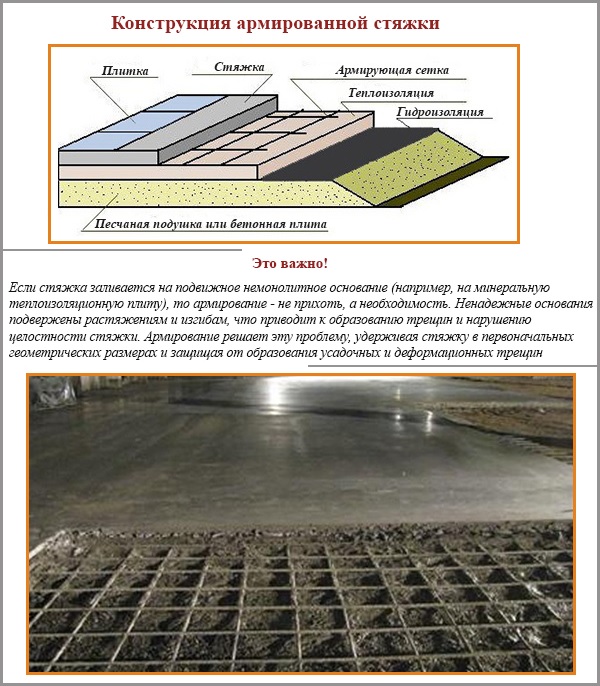

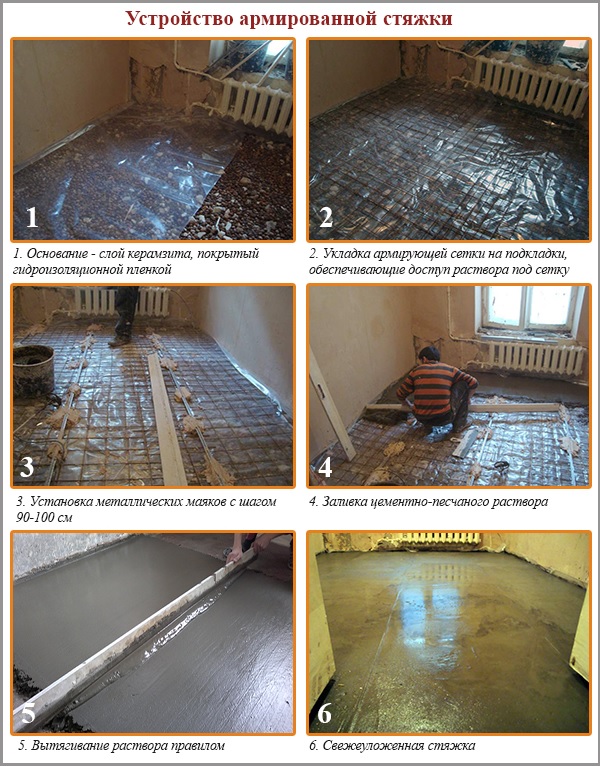
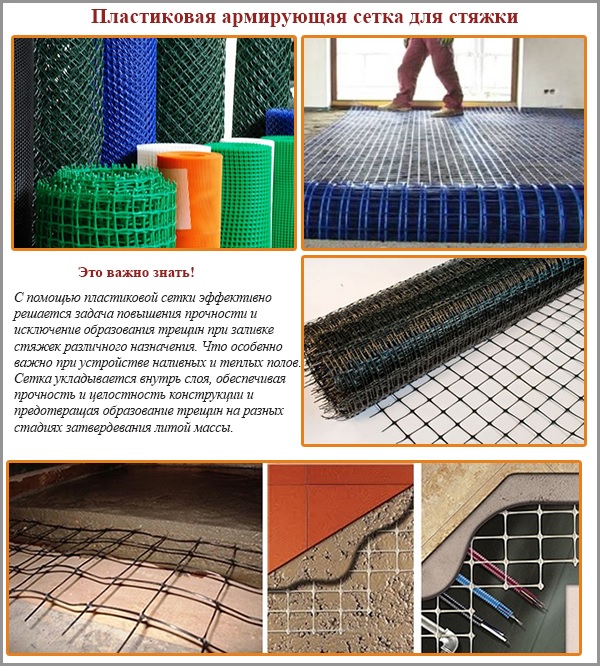
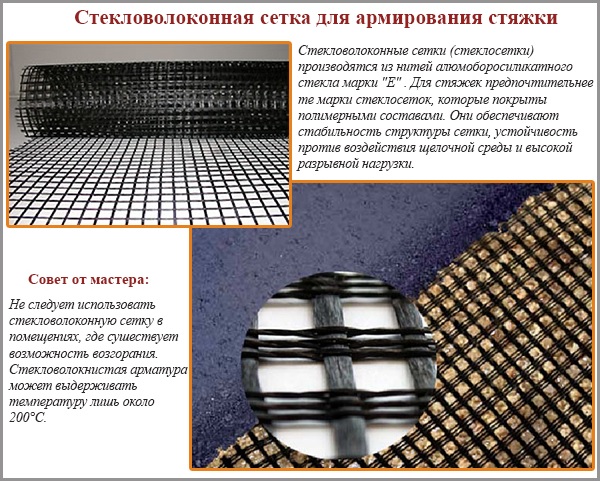
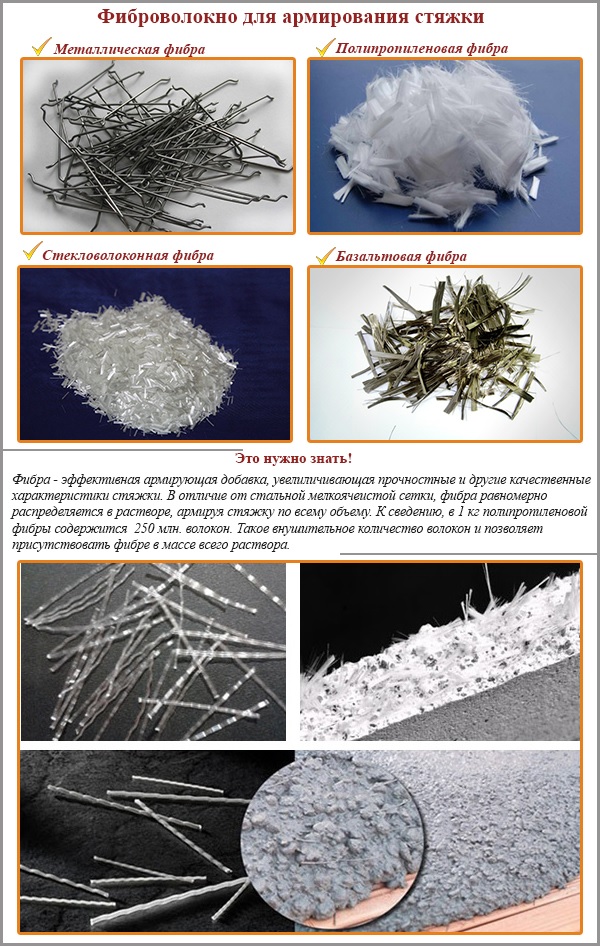

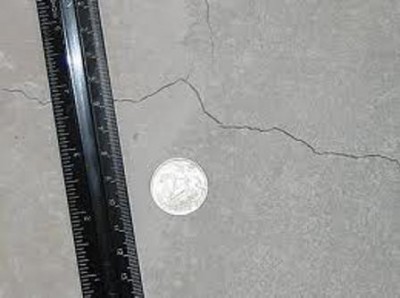
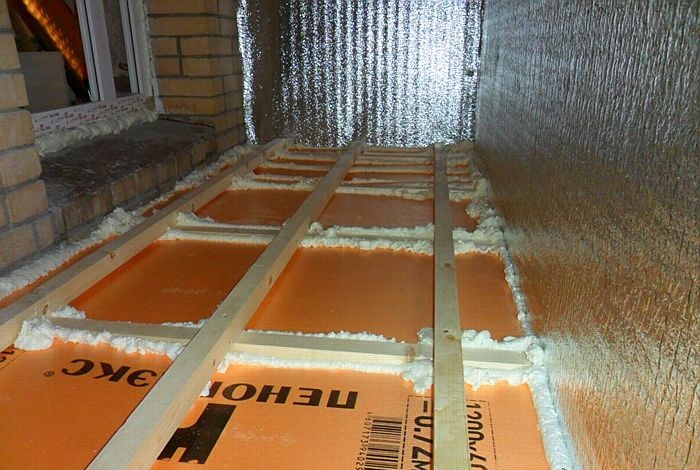
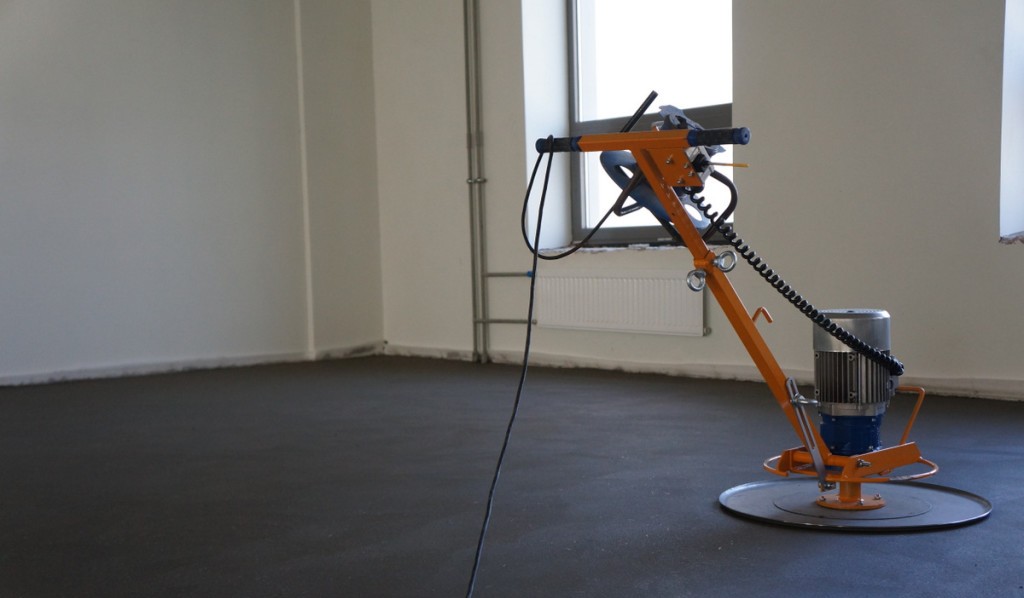
5 comments